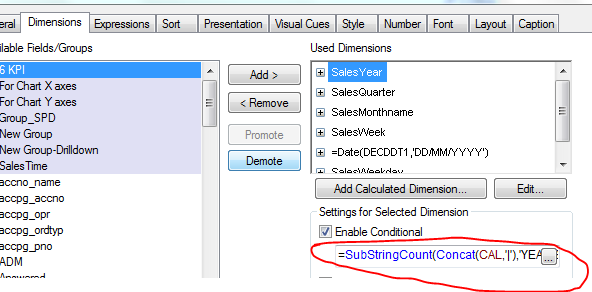Unlock a world of possibilities! Login now and discover the exclusive benefits awaiting you.
- Qlik Community
- :
- All Forums
- :
- QlikView App Dev
- :
- Re: Showing dimensions dinamically in pivot table
- Subscribe to RSS Feed
- Mark Topic as New
- Mark Topic as Read
- Float this Topic for Current User
- Bookmark
- Subscribe
- Mute
- Printer Friendly Page
- Mark as New
- Bookmark
- Subscribe
- Mute
- Subscribe to RSS Feed
- Permalink
- Report Inappropriate Content
Showing dimensions dinamically in pivot table
Hi all,
PFA.
Can u plz tellme how to select dimensions dinamically in pivot table by using adhoc dimensions.
Plz tell me how it works.
Thanks
Accepted Solutions
- Mark as New
- Bookmark
- Subscribe
- Mute
- Subscribe to RSS Feed
- Permalink
- Report Inappropriate Content
Deepak,
Let's have a class. ![]() .
.
Concat(distinct Dimension, '|') -> will concat the distinct(single out of may appearances) values for each member( Bussiness Line, Application Name,Year ,...) of the field 'Dimension' along with extra character '|' to produce a string something like: 'Bussiness Line|Application Name|Year|.....'. Hence, the first parameter of SubSringCount - ''|' & Concat(distinct Dimension, '|') & '|' - >will add two '|' at the starting and closing of the string to produce: '|Bussiness Line|Application Name|Year|.....|'
Now, your expression has been reduced to something like: =SubStringCount('|Bussiness Line|Application Name|Year|.....|', '|Customer Name|')
Then what the SubStringCount does is -> It sees if there is any part of the string like '|Customer Name|' (as mentioned as the second parameter of the function). If it is there then it returns non-zero (position of the sting) which is eventually treated as TRUE.
So when would this condition turns to be true? Well, when you select that value from the Dimension field or nothing is selected at all (because that means all are under scope to be considered), the concat() gets it and produces the string with that value and SubStingCount() finds it and returns a non-zero. If not found, returns zero (FALSE). So this is how your dimension enablilty works conditionally. Hope it helps you comprehend.
- Mark as New
- Bookmark
- Subscribe
- Mute
- Subscribe to RSS Feed
- Permalink
- Report Inappropriate Content
- Mark as New
- Bookmark
- Subscribe
- Mute
- Subscribe to RSS Feed
- Permalink
- Report Inappropriate Content
Hi All,
Can u plz tell me how
=SubStringCount('|' & Concat(distinct Dimension, '|') & '|', '|Customer Name|')
will work.
Thanks
- Mark as New
- Bookmark
- Subscribe
- Mute
- Subscribe to RSS Feed
- Permalink
- Report Inappropriate Content
Hi,
you can you something below in Condition...
=SubStringCount(Concat(CAL,'|'),'YEARS')

- Mark as New
- Bookmark
- Subscribe
- Mute
- Subscribe to RSS Feed
- Permalink
- Report Inappropriate Content
Hi
An example could be Substringcount(concat(distinct '|' & MyDimension & '|'), '|ValueA|) will evaluate as true if ValueA is a possible value in MyDimension and false if it's not. So it can be used as a conditional expression to show/hide things depending on what values the user selected. The | characters are to make sure of an exact match.
Regards
ASHFAQ
- Mark as New
- Bookmark
- Subscribe
- Mute
- Subscribe to RSS Feed
- Permalink
- Report Inappropriate Content
Deepak,
Let's have a class. ![]() .
.
Concat(distinct Dimension, '|') -> will concat the distinct(single out of may appearances) values for each member( Bussiness Line, Application Name,Year ,...) of the field 'Dimension' along with extra character '|' to produce a string something like: 'Bussiness Line|Application Name|Year|.....'. Hence, the first parameter of SubSringCount - ''|' & Concat(distinct Dimension, '|') & '|' - >will add two '|' at the starting and closing of the string to produce: '|Bussiness Line|Application Name|Year|.....|'
Now, your expression has been reduced to something like: =SubStringCount('|Bussiness Line|Application Name|Year|.....|', '|Customer Name|')
Then what the SubStringCount does is -> It sees if there is any part of the string like '|Customer Name|' (as mentioned as the second parameter of the function). If it is there then it returns non-zero (position of the sting) which is eventually treated as TRUE.
So when would this condition turns to be true? Well, when you select that value from the Dimension field or nothing is selected at all (because that means all are under scope to be considered), the concat() gets it and produces the string with that value and SubStingCount() finds it and returns a non-zero. If not found, returns zero (FALSE). So this is how your dimension enablilty works conditionally. Hope it helps you comprehend.
- Mark as New
- Bookmark
- Subscribe
- Mute
- Subscribe to RSS Feed
- Permalink
- Report Inappropriate Content
Thanks ![]()